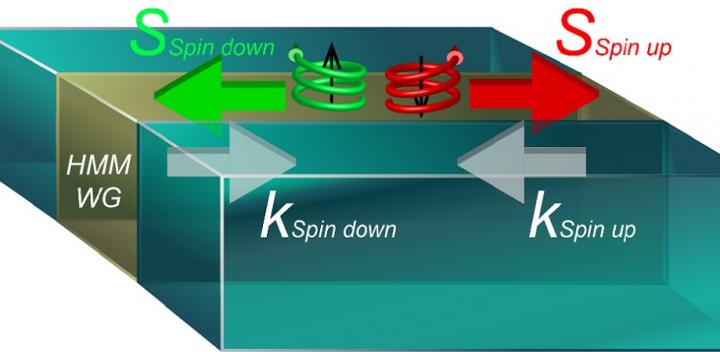Near-field routing of hyperbolic metamaterials

Reversible unidirectional propagation of hyperbolic modes.
Credit: Z. Guo et al.
Flexible control of the propagating direction of near-field light can be realized with hyperbolic metamaterials, using an all-electric metasource.
Near-field light is invisible light at the subwavelength scale. Harnessed for a variety of practical applications, such as wireless power transfer, near-field light has an increasingly significant role in the development of miniature on-chip photonic devices. Controlling the direction of near-field light propagation has been an ongoing challenge that is of fundamental interest in photonics physics and can significantly advance a variety of applications.
So far, propagation of near-field light in a single direction is achieved by specific interactions between the electric dipole and the magnetic dipole in a system, which has led to inevitable complexities in device design. Hyperbolic metamaterials (HMMs), an important class of artificial anisotropic material with hyperbolic isofrequency contours, have attracted attention due to their unique ability to control near-field light by enabling subwavelength confinement of electromagnetic waves. Large wave-vector modes in HMMs are of particular interest because those modes are easier to integrate and have a smaller loss of energy at transfer.
As reported in Advanced Photonics, researchers from Tongji University in China recently demonstrated an all-electric scheme able to flexibly control the propagation direction of near-field light. They reported anomalous unidirectional excitation of hyperbolic modes with large wave-vector at subwavelength scales. According to their research, selective near-field coupling in HMMs is enabled by discrete electric dipoles with different phases, which serve as a metasource composed of all-electric components and with a symmetry-associated inner freedom.
Their research not only addresses the need for an all-electric experimental design scheme for near-field photonics, but also contributes fundamentally valuable symmetry-based excitation principles. Using a Huygens metasource, the researchers were able to observe the unidirectional excitation of hyperbolic bulk modes in a planar HMM. They found that unidirectional excitation in free space is the same as in the vertical direction, but opposite to that in the horizontal direction. These different propagation characteristics in horizontal and vertical directions are unique to the hyperbolic modes. In addition, the researchers used spin metasources to study the directional propagation of light in a planar hyperbolic waveguide. They found that, for the clockwise-rotating spin metasource, only the guided mode propagating from right to left is excited. And for the counterclockwise-rotating source, only the guided mode propagating from left to right is excited.
Overall, the research advances the fields of optical science and information communication, as the results provide the necessary conditions for highly efficient and experimentally verified photonics routing. For emerging applications in integrated optical devices, as well as wireless power transfer, switching, and filtering, this work promises unprecedented flexible control of near-field light.
###
Read the open access research article by Zhiwei Guo et al., “Anomalous unidirectional excitation of high-k hyperbolic modes using all-electric metasources,” Adv. Photon. 3(3), 036001 (2021), doi 10.1117/1.AP.3.3.036001.
All latest news from the category: Physics and Astronomy
This area deals with the fundamental laws and building blocks of nature and how they interact, the properties and the behavior of matter, and research into space and time and their structures.
innovations-report provides in-depth reports and articles on subjects such as astrophysics, laser technologies, nuclear, quantum, particle and solid-state physics, nanotechnologies, planetary research and findings (Mars, Venus) and developments related to the Hubble Telescope.
Newest articles

First-of-its-kind study uses remote sensing to monitor plastic debris in rivers and lakes
Remote sensing creates a cost-effective solution to monitoring plastic pollution. A first-of-its-kind study from researchers at the University of Minnesota Twin Cities shows how remote sensing can help monitor and…

Laser-based artificial neuron mimics nerve cell functions at lightning speed
With a processing speed a billion times faster than nature, chip-based laser neuron could help advance AI tasks such as pattern recognition and sequence prediction. Researchers have developed a laser-based…

Optimising the processing of plastic waste
Just one look in the yellow bin reveals a colourful jumble of different types of plastic. However, the purer and more uniform plastic waste is, the easier it is to…


